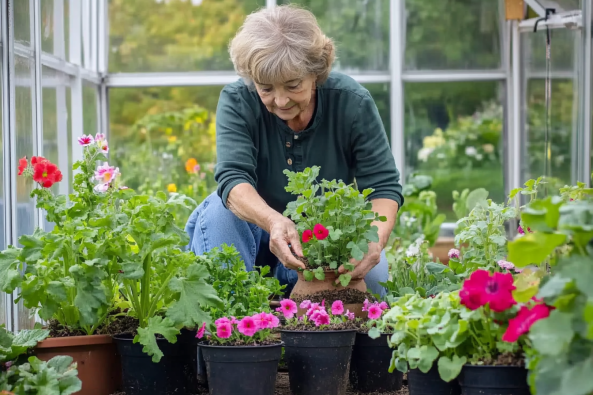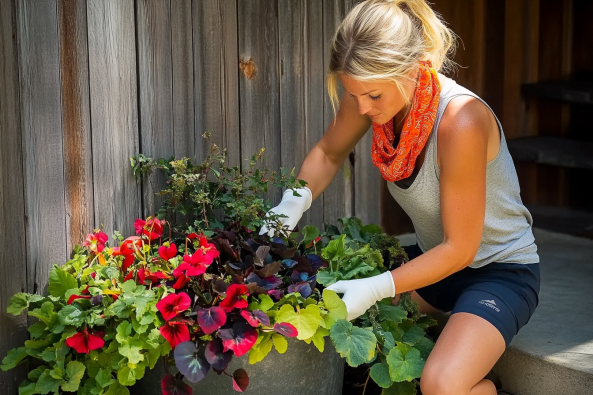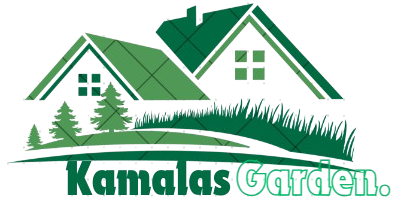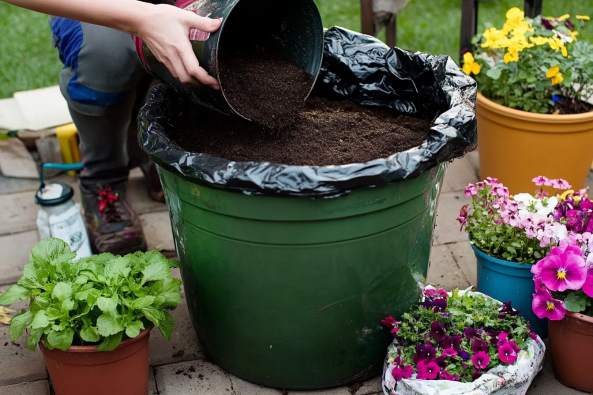What is Container Gardening?
Container gardening is a simple yet effective method of growing plants in containers instead of directly in the ground. This gardening approach allows for greater flexibility and is perfect for those with limited space, such as urban dwellers or individuals without a traditional backyard.
One of the reasons container gardening is an excellent choice for beginners is its ease of management. It requires minimal tools, reduces the risk of common gardening challenges like weeds and soil-borne diseases, and allows for greater control over soil conditions and plant placement.
Benefits of Container Gardening
Space-Saving and Flexibility
One of the greatest advantages of container gardening is its adaptability to any space. Whether you live in an apartment with a small balcony, a house with a tiny patio, or a large home with a full backyard, containers can fit almost anywhere. You can move them around to optimize sunlight exposure, protect plants from harsh weather, or simply refresh your space.
Ideal for Urban Dwellers
Urban residents often have limited outdoor space, making traditional gardening a challenge. Container gardening provides an easy solution by allowing plants to thrive in small areas like balconies, rooftops, and window sills. With the right setup, you can create a lush green oasis even in the middle of a city.
Easier Pest and Weed Control
Since containers elevate plants off the ground, they are less susceptible to common garden pests and weeds. You can also use protective measures like mesh covers or companion planting to keep insects at bay. This makes container gardening a great option for those looking to maintain a healthy garden with minimal effort.
Getting Started with Container Gardening

Choosing the Right Containers
Selecting the appropriate container is crucial for the success of your garden. Here are the most common container types:
- Plastic Containers: Lightweight, affordable, and great for moisture retention.
- Ceramic and Terracotta Pots: Aesthetic appeal but may dry out quickly.
- Wooden Planters: Natural look but require treatment to prevent rot.
- Metal Containers: Stylish and durable but can overheat in direct sunlight.
The size and material of the container also matter. Larger containers hold more soil, which retains moisture better, reducing the frequency of watering. Drainage holes are essential to prevent root rot, so always check for proper drainage before planting.
Selecting the Best Soil Mix
Using the right soil mix can make a significant difference in plant growth. Unlike regular garden soil, which can be dense and compact, a high-quality potting mix provides better aeration and drainage.
Improving Soil Quality:
- Mix in compost for added nutrients.
- Use perlite or vermiculite to improve aeration.
- Avoid using heavy clay soil, as it retains too much moisture.
Picking the Right Plants
Some plants thrive better in containers than others. Here are some excellent choices:
- Vegetables: Tomatoes, lettuce, peppers, and radishes.
- Herbs: Basil, rosemary, mint, and thyme.
- Flowers: Marigolds, petunias, and pansies.
- Succulents: Aloe vera, jade plants, and echeveria.
Annuals vs. Perennials:
- Annuals (e.g., petunias) need to be replanted every year.
- Perennials (e.g., rosemary) return each season with proper care.
Essential Container Gardening Tips
Drainage is Key
Proper drainage prevents water from accumulating at the bottom of the container, which can lead to root rot. To ensure good drainage:
- Choose pots with drainage holes.
- Add a layer of gravel or pebbles at the bottom.
- Use well-draining soil mix.
Watering Techniques
Overwatering and underwatering are common mistakes in container gardening. Follow these best practices:
- Check the soil moisture before watering.
- Water in the morning to prevent evaporation.
- Use self-watering pots for convenience.
- Adjust watering frequency based on the season.
Fertilizing for Healthy Growth
Since container plants rely on a limited amount of soil, they need regular fertilization. Options include:
- Organic Fertilizers: Compost, fish emulsion, and worm castings.
- Synthetic Fertilizers: Commercially available plant food.
A balanced approach, such as feeding every 2-4 weeks, helps maintain healthy plant growth.
Arranging Plants for Optimal Growth
Companion planting can improve plant health and yield. Some great combinations include:
- Basil and tomatoes (boosts flavor and repels pests).
- Marigolds and vegetables (natural pest deterrent).
- Mint and cabbage (keeps insects away).
Sunlight is also crucial. Place sun-loving plants in bright locations and shade-loving plants in less intense light areas.
Maintaining Your Container Garden

To keep your container garden thriving, follow these maintenance practices:
Pruning and Deadheading
Regularly remove dead leaves and spent flowers to promote new growth. This keeps plants looking fresh and prevents disease.
Dealing with Pests and Diseases
Monitor your plants for signs of pests such as aphids or spider mites. Use organic pest control methods like neem oil or insecticidal soap to protect your plants.
Seasonal Care and Winterizing
In colder climates, protect your plants by bringing them indoors or insulating containers with burlap. Some perennials can survive winter with proper mulching.
Common Mistakes to Avoid
Even experienced gardeners make mistakes. Here are some common pitfalls and how to avoid them:
- Overcrowding Plants: Ensure each plant has enough space to grow.
- Neglecting Drainage: Always use pots with drainage holes.
- Choosing the Wrong Soil: Use high-quality potting mix instead of dense garden soil.
Final Thoughts & Next Steps
Container gardening is an excellent way for beginners to enjoy gardening with minimal hassle. With the right containers, soil, and plant choices, anyone can create a thriving garden in any space. If you’re looking for more detailed guidance, check out this beginner’s guide to container gardening.
For additional inspiration and tips, explore this article on container gardening. Happy gardening!

